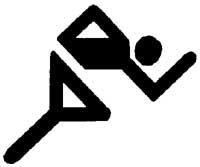By sexual tests

It has long been known that most women have XX chromosomes and most XY chromosomes. But one in a thousand men has XXY chromosomes, a few women only have one X chromosome, one in 20,000 men has two X chromosomes, but they have no Y chromosomes, and some women have XY chromosomes.
What, therefore, defines the sex of a person? Geneticists are slowly approaching the answer to this question, but in the meantime there are human activities that cannot wait for that circular answer, such as women's sports competition. The athlete must prove that he is a “woman” who has no advantages to participate in this competition. And to decide it you have to overcome a test, a “sexual test”. There is the problem: neither the test that has been done so far, nor the new one that will be held at the Barcelona Olympic Games does not satisfy all aspects.
Remember that the human species has 23 pairs of chromosomes in each cell, except for sex cells (eggs and sperm). Sexual cells are formed by cell division or meiosis, so they only have one per pair. Of the 23 pairs of chromosomes of the rest of cells, 22 are formed by apparently equal chromosomes, that is, formed by autosomes and one twenty-three by X and Y sex chromosomes. Except for exceptions, women have a chromosomal supply of XX versus 23 and men supply XY. But, as we have said, there are people who in society are women or men, but who do not have the genetically adequate supply.
Many of them would not know that this is so throughout their lives, if by a concrete situation they did not make a special test. For example, sterility is more frequent in these cases, so in the tests performed when going to the doctor can know that a person suffers alterations in their chromosomal supply. Or if being a high level athlete, she is a woman who has to participate in some international test for the test they are going to do.
The truth is that, intentionally or without laziness, there has been scam in female sports competitions. Let's bring some cases. Austrian skier Erika Schinegger won the gold medal in Portillo in 1966 ahead of Marielle Goitschell and Annie Famos. The one who later became Erik had to return the medal to Marielle Goitschell in a few years. Dora Ratjen, who achieved the height jump mark in 1938, is Herman at present or Léa Caurla and Claire Bressolles, second in the 4x100m test in 1946, have become father several years later. Other cases have been mentioned, but in some of them it has not been possible to demonstrate the existence of fraud.

In these cases, the external aspect of these athletes is that of the “man”, so most of the time they have been rough. This poses a very curious dilemma for athletes: on the one hand, being an increasingly elevated level, they have to train constantly to develop the necessary muscle mass to be in those higher positions (except in a few sports, muscle mass gives advantage and this is the main reason for the difference between male and female brands), and on the other hand, those who have a spectacular muscle mass create all kinds of suspicions about whether they have problems of doping or are “totally women.” The Czech racer Jarmila Kratotxvilova is an example of such events. His “appearance”, despite overcoming all the sexual tests performed, has led him to suffer suspicions and rumors throughout his sports career.
In any case, Sports Entities must ensure that in the female tests do not participate the privileged muscle mass consequence of masculinity. To do this, one must pass a test and there the debate arises, since some geneticists and endocrinologists consider that the test that has been in force to date and the one that wants to implement the future International Olympic Committee (IMT) is not adequate. Let's see what these tests consist of.
In 1966, the women's recognition test was established for the first time. It was a gynecological study that sought to check the absence of male genital organs. In the big competitions there were many participants who needed a lot of time to take this exam and many believe it was offensive.
In 1967, therefore, the International Olympic Committee decided to perform the sexual chromatin test, which is the test in force since the Olympics in Mexico in 1968. Test developed from a discovery made by the Canadian biologist Barr, also known as Bar test. It is based on a very simple principle: one of the two X chromosomes present in each female cell is inactive and condensed (like a compressed spring). These condensed chromosomes form a chromatine corpuscle and can be viewed under a microscope. Men have a single X chromosome and are not condensed. The presence of the condensed X chromosome allows to identify women.
The study can be done using any cell and the simplest is to obtain the oral mucosa by frotis and analyze them. If the corpus of Bar appears in more than 5% of analyzed cells, it has been established that this person is a woman and can participate in tests for women. If 200 cell nuclei were studied and the corpus of Bar was not found, that person was considered chromosomally male.

This system has been in force until recently, despite the controversial intermediaries. It is a very old test, almost prehistory of biology. Another drawback for sports managers is that you have to study many cells and also can only do it a professional with a lot of experience and practice. Although it has been said that it has little reliability, the problems that arise in the case of people with genetic abnormality have been the main cause of the applicants for the disappearance of this test.
On the one hand there are men with Clínefter syndrome (one in 700 men has it). These have two X chromosomes and one Y chromosome that could be considered women using the Bar test. They are men who can scam. On the other hand, there are women who, without having advantages with other women, would not exceed the Bar test. In them are women with Turner syndrome, that is, with a single X chromosome. Since they do not have a second X chromosome, there will be no signs of their femininity, so they will not pass the test.
The case of women with a lack of sensitivity to androgen is more serious, since the frequency of this anomaly is higher. These women have an X and Y chromosome and produce the same number of androgens as normal men, but since they are not sensitive to this hormone, they are in a way women with male genetic supply. Neither would they pass the test, although they did not present any advantage in terms of muscle development. (See table below: The case of María José Martínez Patiño).
The knowledge accumulated in recent years in the field of molecular biology has laid the foundation for developing new techniques. One of them is the technique known as PCR (Polymerase Chain Reaction) or “Chain Reaction by Polymerase”. This technique is the one that, analyzing the DNA of the Egyptian mummies, has revealed some interesting data or the technique of the tests that the police carry out in Britain with cells of suspicious people (by the way, this forensic technique has provoked a great debate in the countries used). But it is a technique especially used for prenatal diagnosis and for the diagnosis of genetic diseases. Using the PCR technique, it is enough to obtain DNA from several cells to perform and analyze copies of it. (See table below: Gene multiplier)
With this new technique, sexual tests have also been prepared, this time studying the presence of the Y chromosome or, more specifically, of the genetic material that only appears on the Y chromosome.

This test has clear advantages over the previous one: it requires few technical means, has high reliability and is of use
This method has been used in Albertville (1992 Winter Olympics) for the first time in sports competition. A total of 400 women carried out this test in Albertville, that is, those who, for the first time, did not have a woman's certificate. The organisers say that there has been no problem and therefore, for the participants of Barcelona this test will also be used.
But the test with this new technique does not have the approval of everyone. Regardless of whether or not the DNA sequence usually appears on the Y chromosome does not correspond to all people socialized as men or women in society. There are those who think that the damage done to the person is too great in those cases in which there is no doubt of his own femininity and is questioned by the result of a test. The test talks about whether this sequence of DNA appears or not, but many geneticists consider that this result should be interpreted in each case and no direct consequence can be extracted without further ado.
On the occasion of the Barcelona Olympic Games, the prestigious Catalan geneticist Xavier Estivill rejects the Olympic Committee when he asks him to participate in the assessment of these tests. In his opinion, for science the debate about what defines women and masculinity is still open, so the massive use of this type of test can cause harm. According to Estivill, the minimum would be to create an advisory service that clearly explains the meaning of the outcome to women who do not pass the test. But meanwhile, it would not be ethical to use this type of test, the psychological consequences are very hard.
The claim for the inadequacy of the sexual test has a history as long as the test. M.A. Ferguson-Smith (from the Department of Pathology of the University of Cambridge) and A. de la Chapelle (from the Department of Medical Genetics of the University of Helsinki) are perhaps the most prominent on this path. According to them, what the athlete needs is a good analysis of his general state of health and exploration for this purpose would be enough to avoid all kinds of frauds.
The International Federation of Amateur Athletics has endorsed this approach to the problem and since last year the State Federation of Athletics has been in charge of carrying out medical recognitions and issuing certificates of femininity.
The International Olympic Committee, in its desire to give friendly treatment to the federation of athletics (the role of federations is insignificant in the Olympic Games), has stated that it will accept, without further evidence, the certificates of femininity issued by it. Some have not seen this intermediate decision very well with good eyes, and the existence of documents based on different techniques and principles can provoke curiosities. A woman with the certificate issued by the federation of athletics may not exceed the test performed using the PCR technique, so she would be a woman for athletics, but not for swimming, for example.
Others fear that athletic federations in some countries take advantage of the situation and scam by delivering certificates to men. The opponents of the test have argued to those who say so: due to the frauds carried out with the doping test (presentation of the urine of another) the urine for the random doping tests will be collected before a judge. They believe that the restlessness that they will be caught on this road can bring back those who would be tempted by fraud.
The case of María José Martínez Patiño
María José Martínez Patiño was a 24-year-old runner (100 m of fences) who participated in the Universal World Games of Kobe (Japan) in 1986. However, he could not participate, since he was genetically declared a man.
For him it was a huge blow: “I was down. I had given my life to sport. But it never occurred to me to question my status as a woman.”

A few months later, in another race, he was again asked to appear the injury and, in addition, on this occasion, he finished his sports career. He replied no, so a week later the Federation of Athletics made public the ban to participate in the contest. They erased their brands, lost their scholarship as an athlete and was expelled from Blume headquarters in Madrid for high level athletes. He was also forbidden to access his sports facilities because he wanted to continue training.
Two and a half years later, after several paid tests of his pocket, the International Federation of Amateur Athletics again admitted him to contest, being credited that his genetic alteration does not give him advantages. Therefore, it can again compete in women's testing. In January 1989 he was able to return to Dallas because he, obstinate, never stopped training.
GENE MULTIPLIER

The technique called PCR (Polymerase Chain Reaction) or Chain Reaction by Polymerase allows the realization of millions of copies of a certain gene, that is, of a piece of DNA in a short period of time, facilitating their identification. Only a few cells need to be extracted from the entire DNA chain (1). To this chain we only have to add, in appropriate conditions, the primers, the polymerase enzyme, the free nucleotides and other reagents corresponding to the part of the DNA that is desired to multiply (2).
Primers are short sequences of monofilament DNA manufactured in laboratory. This technique consists of using two types, the two ends of the gene to be multiplied.
When the DNA chain extracted from the cell nucleus is heated, that is, it is separated into two simple filaments. If the first identifies the additional portion of filament that corresponds to it, it will join in it and will be recomposing the double filament in the single strand of DNA, joining its complementary nucleotides (couples will always be A-T and G-C). This occurs with the help of the polymerase enzyme, which moves through the gene after placing each new nucleotide in place (3).
After this process, we will obtain two double filaments of a double strand of DNA. Keeping the heat conditions, these chains will also become a filament and, repeating the process, if the DNA chain taken for the test contains the part of DNA that is wanted to identify, this part will be repeated millions of times.
Using the technique called electrophoresis, the next step will be “see” if that gene has appeared or not. Being so repeated, it will emit a very broad band that will look clear.
Buletina
Bidali zure helbide elektronikoa eta jaso asteroko buletina zure sarrera-ontzian











